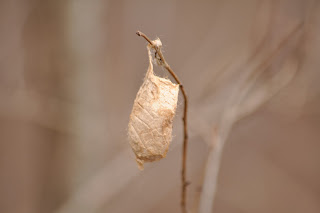With this entry I would like to point out some of the vines that are easy to spot when the forest is bare of foliage. The most obvious vine is poison ivy , a member of the cashew family. It grows abundantly along the path, mostly in the first section. All parts of poison ivy can cause allergic reactions to the majority of humans. It is an allergen, not a poison. Most birds and mammals are not affected by the urushiol, the oil that causes the allergic reaction. Poison ivy climbs straight up the tree; it does not spiral like honeysuckle. Mature plants can grow up 75 feet along a tree trunk. Look for the hairy vine; that's poison ivy. Don't touch; don't eat; don't burn.

This is a great time to view wild grape that grows in Virginia forests. There are plenty of interesting specimens at Government Island. It is easy to ID with its shreddy, brownish-gray bark. Think "Tarzan" and you'll spot wild grape. Grape uses tendrils to climb along tree trunks, but then it hangs and twists and loops. But don't look for the grapes. They were eaten months ago by the wildlife!
If you want to see berries, look for the greenbrier. It is the vine that maintains green stems through the winter. It is a tough, woody vine with thorns and blue-black berries. Many varieties of birds eat the berries and use the greenbrier thickets for nesting and protection from predators. While beneficial for the birds, greenbrier can be a parasitic problem when it smothers other plants and blocks out the sunlight.
Speaking of blocking sunlight...one more vine that can be easily seen near the parking lot bridge is the highly invasive mile-a-minute vine. It has very intriguing leaf shapes and rather attractive berries, but it is a scourge where ever it grows. Right now it is dead yet still smothering the native vegetation. See what I mean. And it has nasty little stickers on the vine.
I also noticed that the beavers have been busy with new trees gnawed down out near the marsh overlook. One tree either didn't taste right or the beavers got spooked. It was damaged but still standing

On the way out of the park, I spotted this insect cocoon, or whatever it is. Haven't seen one like this before. Time to get the book out and see what it is.

Until next time, enjoy the woods in winter whether at Government Island or any of the other great parks available in your area. Resolve to get outside more in 2013.
Maria C., Virginia Master Naturalist





No comments:
Post a Comment